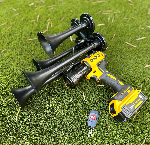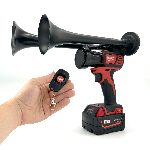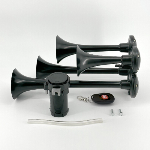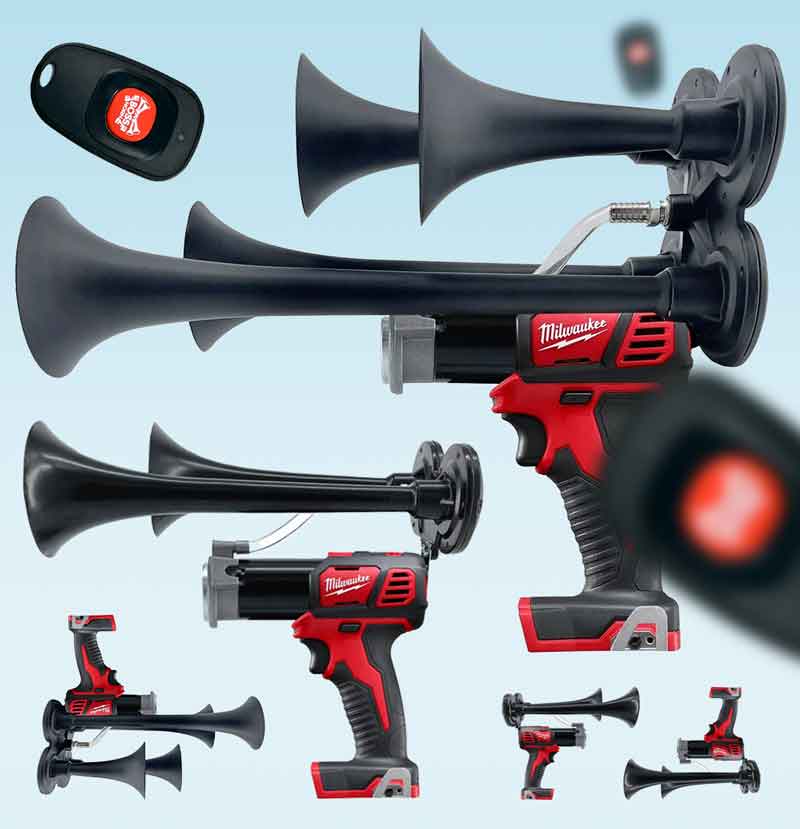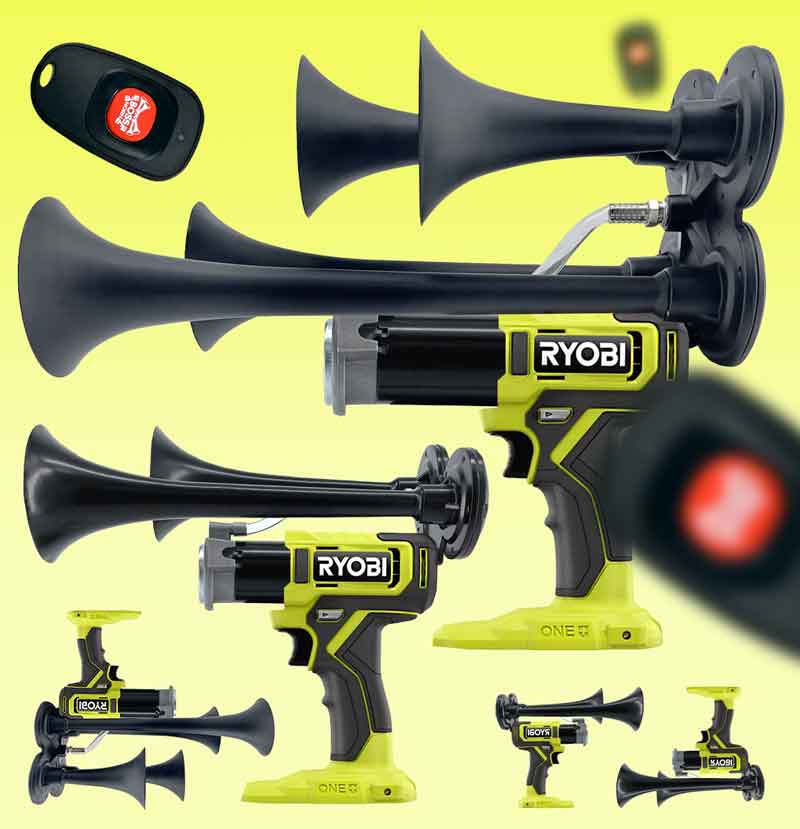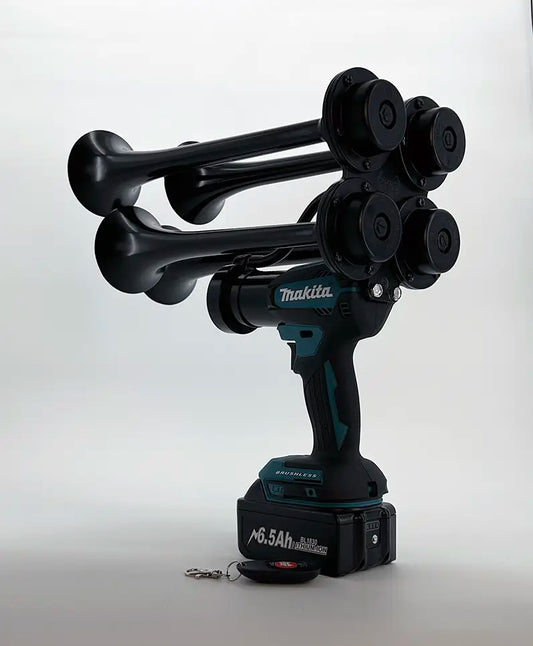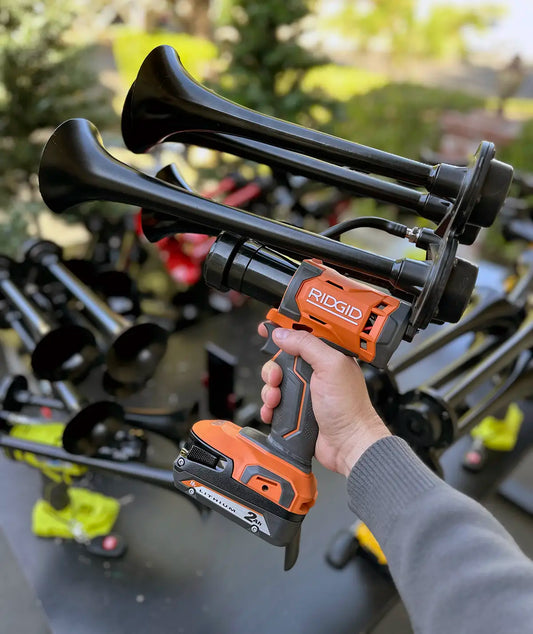A car horn, a familiar sound on roads worldwide, serves as a crucial means of communication between drivers, pedestrians, and others on the road. It is a safety feature that alerts others to a vehicle's presence and is used to signal warnings, emergencies, and greetings. Evolution of car horns began in the late 1800s when steam-powered automobiles emerged, and their designs have since undergone remarkable advancements. Today, car horns play an essential role in ensuring road safety and maintaining smooth traffic flow.
In the early days, car horns were primitive and manually operated. Automobiles required a separate bulb horn, which the driver had to squeeze by hand to create a honking sound. However, this manual approach posed challenges, as it could distract the driver from focusing on the road. As technology progressed, engineers sought innovative solutions to improve the functionality and reliability of car horns.
The introduction of electric car horns revolutionized automotive safety. Electric horns operate using a simple but effective mechanism. When a driver presses the horn button on the steering wheel, an electrical current is sent to the horn assembly, consisting of a diaphragm and an electromagnet. The electrical current flows through the electromagnet, creating a magnetic field that pulls the diaphragm, which then rapidly vibrates back and forth. This vibration generates a distinctive honking sound that can catch the attention of people nearby.
Though the principle remains the same, modern car horns have witnessed several refinements and enhancements. Manufacturers have developed different types of horns, including single-note horns, dual-note horns, and even air horns, to provide drivers with a range of audio options for various situations. The honk sound is often regulated by government guidelines to ensure its loudness and duration meet specific standards, promoting consistent audibility and reducing noise pollution.
Car horns have become integral to maintaining road safety, contributing to accident prevention and effective communication among drivers. Statistics show that 70% of horn honks in the United States are used to prevent accidents or collisions. For instance, a study conducted in New York City revealed that using the car horn promptly prevented approximately 47% of potential accidents. Such figures emphasize the significant role car horns play in alerting others to hazardous situations on the road, potentially saving lives.
In conclusion, the development and modernization of car horns have transformed them from manual, hand-operated devices to electric-powered safety features. The evolution of car horns has allowed for better communication, smoother traffic flow, and increased road safety. With their usefulness apparent in preventing accidents and navigating complex traffic situations, car horns continue to play a vital role in ensuring a harmonious coexistence on the roads.
How Does a Car Horn Work: Understanding the Mechanics Behind This Essential Safety Feature
A car horn is an integral component of any vehicle, serving as a crucial safety feature that alerts both pedestrians and other drivers to your presence on the road. This article aims to dissect the workings of a car horn, providing a comprehensive understanding of its mechanics, electrical systems, and sound production. By exploring the intricate details behind how a car horn operates, we can gain insights into its advantages, potential faults, and maintenance requirements. So, let us delve deeper into the inner workings of this essential automotive device and uncover the fascinating aspects that make it an indispensable tool for road safety.
Electromechanical Device
A car horn is an essential component of every vehicle, designed to alert others of the driver's presence and to communicate in various traffic situations. It is a simple yet ingenious electromechanical device that operates through the production of sound waves.
Components
A typical car horn consists of several key components:
- Horn button: Located on the steering wheel, it is the user interface for activating the horn.
- Relay: A switch that controls the flow of electricity to the horn.
- Electromagnetic coil: Creates a magnetic field when an electric current passes through it.
- Diaphragm: A thin metal disc that vibrates to produce sound waves.
- Housing: Encloses the components and amplifies the sound.
Circuit Operation
When the driver presses the horn button, an electrical circuit is completed, allowing current to flow from the vehicle's battery to the horn. The relay activates and delivers power to the horn. Once the current flows through the electromagnetic coil, it generates a magnetic field, causing the diaphragm to move rapidly back and forth. This motion creates compressions and rarefactions in the air, producing sound waves that we hear as the horn's distinct honking sound.
Types of Car Horns
There are various types of car horns available, each producing a unique sound:
- Single-tone horn: The most common type, producing a single, loud honk.
- Dual-tone horn: This type consists of two horns with different tones, creating a more harmonious sound.
- Air horn: Typically found in large vehicles, such as trucks or trains, it operates using compressed air and produces a very loud sound.
- Musical horn: These horns are capable of playing musical tunes or melodies.
Regulations and Safety
In many countries, car horns are subject to regulations to prevent excessive use and noise pollution. Drivers should use their car horn responsibly, primarily as a safety feature to warn others of potential danger or to signal their presence in challenging traffic situations.
Statistics
According to a survey conducted in 2020:
- 78% of drivers stated that they use their car horn at least once a week.
- 48% of drivers find the sound of car horns annoying.
- 92% of drivers believe that car horns are an important safety feature.
https://youtube.com/watch?v=d980sdQ1hRo
1. What causes the loud noise when I press my car's steering wheel?
When you press the steering wheel of your car, you trigger a specific mechanism that ultimately produces the loud noise associated with the car horn. This mechanism is designed to alert pedestrians and other drivers of your presence or to signal an emergency situation. To better understand how this works, let's dive into the components involved:
- The switch: When you press the horn button on your steering wheel, you activate an electrical switch that completes a circuit.
- The relay: Once the circuit is closed, an electrical signal is sent to the horn relay, which acts as a control device.
- The electromagnetic coil: The horn relay directs the electrical current to an electromagnetic coil located in the horn itself.
- The diaphragm: The electromagnetic coil creates a magnetic force that pulls a thin metal diaphragm towards it.
- The contact points: As the diaphragm is pulled, a set of contact points located behind it are also pulled together, completing another electrical circuit.
- The sound: Once the contact points are closed, a high-powered electrical current flows through the circuit, causing the diaphragm to vibrate rapidly. This vibration pushes air through a small opening in the horn, creating the familiar sound.
2. What role does electricity play in car horns?
Electricity serves as the driving force behind the functioning of a car horn. By utilizing electrical currents, a car horn can generate the necessary sound to get attention on the road. Here's a breakdown of the electrical aspects involved in its operation:
- Completion of the circuit: When you press the horn button, it completes an electrical circuit, allowing the flow of electricity to the horn.
- Magnetic field generation: The electrical current travels through the horn relay, which generates a magnetic field in the electromagnetic coil.
- Diaphragm activation: The magnetic force from the electromagnetic coil attracts and pulls the metal diaphragm towards it, creating movement.
- Contact points closure: As the diaphragm is pulled, it also closes a set of contact points behind it. This closure forms a secondary electrical circuit.
- Current amplification: The closed contact points allow a high-powered electrical current to flow through the circuit, further enhancing the energy sent to the horn.
- Sound production: The amplified current causes the diaphragm to vibrate intensely, resulting in the emission of loud sound waves through the horn opening.
3. How does the diaphragm contribute to the sound produced by the car horn?
The diaphragm, a thin metal component within the car horn, plays a crucial role in generating the sound that emanates from the horn. Its specific design and material properties contribute to the quality and tone of the noise produced. Here's how the diaphragm contributes:
- Vibration generation: When the electromagnetic coil creates a magnetic force, it attracts the metal diaphragm towards it, initiating rapid vibrations.
- Acoustic amplification: The frantic vibrations of the diaphragm cause the air surrounding it to also vibrate, amplifying and projecting the sound waves created.
- Resonance effect: The diaphragm's size, shape, and tension are carefully engineered to resonate specific frequencies, resulting in the desired pitch and sound characteristics.
4. Why is the horn sound so loud compared to other car noises?
The horn sound is deliberately designed to be louder than other car noises in order to effectively capture attention and provide clear and audible warnings in various situations. Several factors contribute to its high volume:
- Amplification mechanisms: The electrical circuitry in the horn system is designed to amplify the energy provided by the car's electrical system, resulting in a more powerful sound output.
- Acoustic design: The shape and size of the horn, including the diaphragm, are optimized to maximize the amplification and projection of sound waves, increasing overall volume.
- Regulatory requirements: Many jurisdictions enforce legislation regarding the minimum volume level a car horn must reach. Vehicle manufacturers ensure compliance with these regulations to maintain safety standards.
5. How does the car horn system differ from older mechanical horn designs?
Modern car horn systems, utilizing electricity and electromagnetism, have evolved from earlier mechanical horn designs. Understanding their differences sheds light on the advancements made in car horn technology. Here are the primary distinctions:
- Energy source: Mechanical horns relied on manually exerted physical force, such as squeezing a bulb or pulling a lever, to produce sound. Electric car horns, in contrast, are powered by the vehicle's electrical system and responding to the driver's input.
- Sound production: Mechanical horns often utilized a simple resonating metal plate or a series of reeds to create sound. Electric horns employ diaphragms vibrating within an electromagnetic field, allowing for greater sound control and consistency.
- Sound variety: Electric horns offer the ability to produce a wider range of sounds, including different pitches and tones, through alterations in the equipment and electrical signals. Mechanical horns typically had limited sound variations.
In summary, a car horn operates by utilizing electricity to activate an electromagnetic coil that, in turn, generates vibrations in a metal diaphragm. These vibrations cause the emission of powerful sound waves, projecting the distinct and loud noise associated with car horns. The electrical circuitry and design elements within the horn system contribute to its volume, ensuring it can effectively capture attention on the road. Modern car horns have evolved from earlier mechanical designs, providing enhanced sound control and versatility.
Conclusion
In conclusion, a car horn is a crucial safety device that plays a vital role in alerting other road users in various situations. It operates through a simple mechanism that involves an electrical circuit, a relay, a switch, and a diaphragm or horn itself. When the driver presses the horn button on the steering wheel, an electrical current is sent through the circuit, activating the relay. The relay then amplifies the current and directs it to the diaphragm, causing it to vibrate and produce sound waves. The pitch and loudness of the horn can be adjusted based on the design of the diaphragm and the level of current supplied to it. Additionally, some cars employ multiple horns or use different horn patterns to communicate different messages on the road. Overall, the car horn serves as an essential communication tool that enhances road safety and helps avoid accidents.


